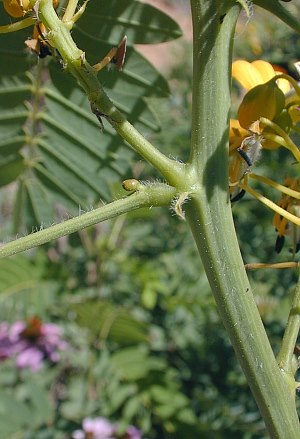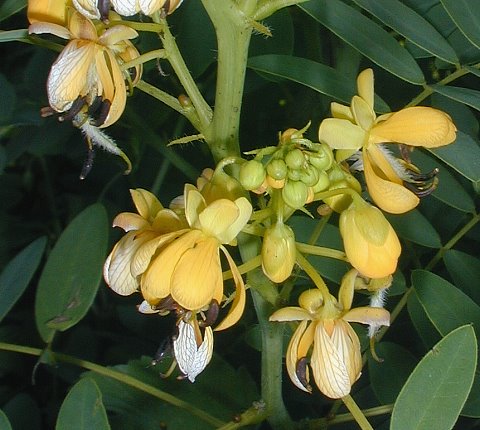Description: This herbaceous perennial plant is largely unbranched and up to 6' tall. The stout central stem is light green, and slightly hairy in the upper stem and at the base of the upper compound leaves. The compound leaves are evenly pinnate with about 5-10 pairs of leaflets. The gray-green to medium green leaflets are individually up to 2½" long and ¾" across. Each leaflet is oblong or elliptic-oblong and smooth along the margins; it has a small pointed tip and a short petiolule (basal stalklet) that is 1/8" (3 mm.) in length or less. On the upper side of a petiole near its base is a small club-shaped gland; it is ovoid or dome-shaped above a short stalk. This gland secretes nectar to attract certain kinds of insects (see below for more information). At the base of each petiole, there is a pair of small linear-lanceolate stipules; they are tardily deciduous.

The central stem terminates in either a raceme or panicle of flowers about ½-1' long. In addition, smaller racemes of flowers often develop from the axils of upper compound leaves. Each flower is about ¾" across; it has 5 pale yellow sepals, 5 yellow petals, 10 stamens with dark brown anthers, and a pistil with spreading white hairs. The petals have a tendency to turn white as they age, while the hairy pistil eventually develops into a seedpod. In each flower, the stamens are divided into 3 groups: the lower 3 stamens have long anthers and long filaments, the middle 4 stamens have long anthers and short filaments, while the upper 3 anthers have short anthers and short filaments. Of these, the lower and middle stamens are fertile, while the upper stamens are sterile. The flowers have no nectaries. The blooming period is mid- to late summer, which lasts about a month. There is no noticeable floral scent. The flattened seedpods are about 3-4" long, ½" across, and dark brown when they are fully mature; each seedpod has 10-18 segments, and each segment contains a single seed that is less than than ¼" long. The seeds are ovoid-rhombic in shape and flattened; they are nearly as wide as they are long. The root system consists of fibrous roots and rhizomes. This plant often forms vegetative colonies from the rhizomes.

Cultivation:
The preference is partial to full sun, and moist to mesic conditions. A
rich loamy soil is preferred, although sandy and rocky soil are also
tolerated. This plant can become quite tall when the soil is fertile
and moist; it may flop over while the flowers and seedpods are
developing.
Range & Habitat:
The native Wild Senna occurs in scattered counties throughout Illinois;
it is perhaps a little more common in the east than the west (see Distribution
Map). This species is occasional in some areas, and uncommon
or absent in others. Populations in the wild are probably declining as
a result of modern development. Habitats include moist meadows near
rivers, savannas, fens, pastures, and roadsides. Some disturbance is
beneficial when it reduces competition from shrubs and trees.
Occasionally, Wild Senna is found in flower gardens because of the
showy flowers.

Faunal Associations: The flowers atttract bumblebees primarily, which seek pollen. Halictid bees also visit the flowers for pollen, but are less likely to achieve cross-pollination. The extra-floral nectaries, on the other hand, attract primarily ants and a few other insects, including ladybird beetles and flies. It is possible that some of these insects protect the plant from other insects that would attack the foliage. The caterpillars of some Sulfur butterflies rely on the foliage of Senna spp. (Sennas) as a source of food. In Illinois, this includes Eurema nicippe (Sleepy Orange), Phoebis philea (Orange-Barred Sulfur), and Phoebis sennae eubule (Cloudless Sulfur). Other insects that feed on Sennas include caterpillars of the moths Ascalapha odorata (Black Witch) and Pleuroprucha insulsaria (Common Tan Wave); caterpillars of the last species feed on the flowers. Mammalian herbivores usually avoid consumption of the foliage, which has purgative properties. The seeds may be eaten by some upland gamebirds, particularly the Bobwhite.

Photographic
Location:
The photographs were taken of plants growing in an herbal garden at
Meadowbrook Park, Urbana, Illinois, and in the wildflower garden of the
webmaster in the same city.
Comments:
This is a striking plant while in bloom and it has attractive foliage.
It is difficult to distinguish Wild Senna from Senna
marilandica (Maryland Senna), which has a very similar
appearance. Generally, Wild Senna has a more northern distribution than
Maryland Senna, but in Illinois their ranges overlap. On Wild Senna,
the pistils of the flowers have long white hairs, while in Maryland
Senna these hairs are shorter and more appressed. Wild Senna has a
tendency to produce a greater abundance of flowers than
Maryland Senna, although this characteristic is influenced by
environmental conditions, such as the abundance of sunlight. Another
scientific name for Wild Senna is Cassia
hebecarpa.